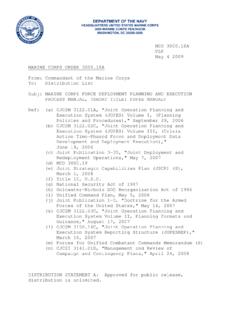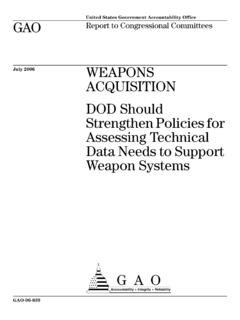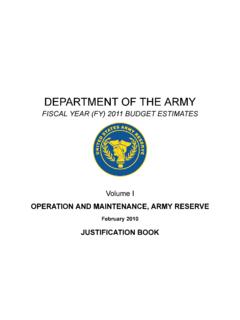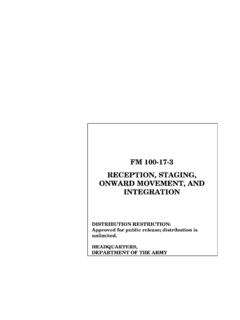Transcription of JP 3-35 Deployment and Redeployment Operations
1 07 May 2007 Deployment and RedeploymentOperationsJoint Publication 3-35 PREFACEi1. ScopeThis publication provides doctrine and principles for planning and executing Deployment , jointreception, staging , onward movement, and integration (JRSOI), and Redeployment of the Armed Forcesof the United States. It explains the Deployment , JRSOI, and Redeployment processes, and planningand execution considerations that may impact United States force projection Operations . It discussesthe responsibilities and command relationships for supported and supporting combatant commands andServices, and the interaction with other Department of Defense and federal agencies, foreign nations,allies, multinational organizations, and other PurposeThis publication has been prepared under the direction of the Chairman of the Joint Chiefs of Staff(CJCS). It sets forth joint doctrine to govern the activities and performance of the Armed Forces of theUnited States in Operations and provides the doctrinal basis for interagency coordination and for USmilitary involvement in multinational Operations .
2 It provides military guidance for the exercise of authorityby combatant commanders (CCDRs) and other joint force commanders (JFCs) and prescribes jointdoctrine for Operations and training. It provides military guidance for use by the Armed Forces inpreparing their appropriate plans. It is not the intent of this publication to restrict the authority of the JFCfrom organizing the force and executing the mission in a manner the JFC deems most appropriate toensure unity of effort in the accomplishment of the overall Applicationa. Joint doctrine established in this publication applies to the commanders of combatant commands,subunified commands, joint task forces, subordinate components of these commands, and the 3-35b. The guidance in this publication is authoritative; as such, this doctrine will be followed exceptwhen, in the judgment of the commander, exceptional circumstances dictate otherwise.
3 If conflicts arisebetween the contents of this publication and the contents of Service publications, this publication willtake precedence unless the CJCS, normally in coordination with the other members of the Joint Chiefsof Staff, has provided more current and specific guidance. Commanders of forces operating as part ofa multinational (alliance or coalition) military command should follow multinational doctrine and proceduresratified by the United States. For doctrine and procedures not ratified by the United States, commandersshould evaluate and follow the multinational command s doctrine and procedures, where applicable andconsistent with US law, regulations, and doctrine. For the Chairman of the Joint Chiefs of StaffWALTER L. SHARP Lieutenant General, USA Director, Joint StaffSUMMARY OF CHANGESREVISION OF JOINT PUBLICATION 3-35 DATED 7 SEPTEMBER 1999 iiiConsolidates Joint Publication (JP) , Joint Tactics, Techniques, and Proceduresfor Joint reception , staging , onward Movement, and Integration, and JP 3-35, JointDeployment and Redeployment the use of the term military Operations other than war (MOOTW).
4 Expands on the operational/employment focus of Deployment and the US Transportation Command Deployment distribution Operations centerand combatant command joint Deployment distribution Operations centers as keyentities in synchronizing and optimizing Deployment and distribution on the linkages with the Defense Transportation the joint operation planning process in the Deployment andredeployment planning the terms and discussions for various operational areas as Deployment and Redeployment Operations in the conduct of homelanddefense and civil an appendix (Appendix A) providing an overview of the enablers supporting the joint Deployment and Redeployment on global force management and force on force visibility and in-transit visibility the Joint Operation Planning and Execution System activities, functions, the construct of contingency and crisis action a new definition for force visibility.
5 Modifies the definitions for automated identification technology and force tracking .ivSummary of ChangesJP 3-35 Intentionally BlankTABLE OF CONTENTSvPAGEEXECUTIVE ixCHAPTER IOVERVIEW I-1 National Defense I-3 Global Force Management and Force 1-3 Integrated Planning and Execution Integrated Employment and I-11 Deployment Process and Force Sustainment I-17 I-17 Training, Exercises, and IIRESPONSIBILITIES II-1 Secretary of II-1 Chairman of the Joint Chiefs of II-2 Geographic Combatant II-4 Functional Combatant II-8 Joint Task Forces .. II-12 Military Departments and Department of Defense II-13 Other Government II-17 Other Transportation II-19 CHAPTER IIIPLANNING III-1 Joint III-1 General Planning III-3 Deployment III-9 Synchronizing and Balancing the III-17 Deployment Planning Requirements and III-18 III-19viTable of ContentsJP 3-35 CHAPTER IVPRE- Deployment ACTIVITIES IV-1 IV-4 IV-7 Assemble and Marshal IV-7 CHAPTER VMOVEMENT V-1 V-1 Movement V-4 Force V-8 V-11 Other V-12 CHAPTER VIJOINT reception , staging , onward MOVEMENT, AND INTEGRATION VI-1 Principles of Joint reception , staging , onward Movement, and VI-3 Elements of Joint reception , staging , onward Movement.
6 And VI-6 VI-9 VI-20 onward VI-29 CHAPTER VIIREDEPLOYMENT VII-1 Redeployment VII-1 Pre- Redeployment VII-5 VII-8 Joint reception , staging , onward Movement, and Integration .. VII-9viiTable of ContentsAPPENDICESAE nabler A-1 BJoint Deployment , and Joint reception , staging , onward Movement, and Integration,and Redeployment Process Map C-1 DAdministrative D-1 GLOSSARYPart IAbbreviations and GL-1 Part II Terms and GL-6 FIGURESI-1 Joint Operation Planning Activities, Functions, and I-5I-2 Processes for Projecting the Joint I-6I-3 The Strategic Mobility I-9I-4 Joint Operation Planning I-11I-5 Phasing I-12I-6 Deployment Planning I-19II-1 Responsibilities of Supported Combatant II-5II-2 Responsibilities of Supporting Combatant II-7II-3 Defense Logistics Agency II-16 III-1 Key Service Documents for Deployment III-2 III-2 General Planning III-4 III-3 Examples of Infrastructure III-9 III-4 Force Tracking is Part of Force III-11 III-5 Sources of Logistic III-13 III-6 Host Nation Negotiating III-14IV-1 Joint Force Pre- Deployment IV-2V-1 Joint Force Movement V-2V-2A Generic Joint Deployment Distribution Operations Center V-7V-3 Force V-9V-4In-Transit V-11VI-1 Joint reception , staging , onward Movement, and Integration VI-2VI-2 Principles of Joint reception , staging .
7 onward Movement, and VI-4viiiTable of ContentsJP 3-35VI-3 Elements of Joint reception , staging , onward Movement, and VI-6VI-4 Joint reception , staging , onward Movement, and Integration Port of Debarkation Support VI-11VI-6 Seaport of Debarkation VI-13VI-7 Port Support Activity and Port Operations Group VI-15VI-8 reception Planning VI-16VI-9 staging Force-Related VI-21VI-10 Intermediate staging VI-23VI-11 onward Movement VI-24VI-12 Critical Functions of onward VI-25VI-13 Host-Nation Support to onward Force Redeployment VII-2A-A-1 Enabling A-A-2B-A-1 Joint Force Deployment B-A-2B-B-1 Joint reception , staging , onward Movement, and Integration B-B-2B-C-1 Joint Force Redeployment B-C-2 EXECUTIVE SUMMARYCOMMANDER S OVERVIEW ixProvides an Overview of Deployment and Redeployment OperationsDetails the Key Deployment and Redeployment Operations ResponsibilitiesCovers the Process of Deployment PlanningDiscusses Predeployment ActivitiesAddresses the Movement Phase of DeploymentExplains Joint reception , staging , onward Movement, and IntegrationProvides a Discussion of Redeployment OperationsOverviewThe capability to projectforces to the operationalarea and rapidly integratethem into the joint forceas directed by the jointforce commander Deployment , reception , and integration of US air, land,maritime, and special Operations forces in support of combatantcommander (CCDR) requirements is a series of operational eventsenabled by logistics.
8 The Deployment process begins withplanning for force projection under contingency planning or in acrisis. The operation plan (OPLAN) contains a deploymentconcept and may contain time-phased force and Deployment data(TPFDD) that identifies force requirements and flows the forcesinto the theater as required by the concept of Operations (CONOPS). Deployment Operations enable joint forces toconduct campaigns, major Operations , and to respond to othercontingencies by securing positional advantages that contributeto the achievement of operational and strategic any given time there could be multiple requirements to employmilitary forces. Each operation could have a different strategicpriority, and could be of a different size and scope. To effectivelysupport multiple requirements, and apply the right level of priorityand resources to each, requires effective global joint Deployment process is divided into four iterative andoften simultaneous phases: planning, predeployment activities,movement, and joint reception , staging , onward movement, andintegration (JRSOI).
9 XExecutive SummaryJP 3-35 Deployment planning occurs during both Joint OperationPlanning and Execution System contingency planning and crisisaction planning. It is conducted at all command levels and byboth the supported and supporting commanders. Deploymentplanning activities include all action required to plan for thedeployment and employment of activities are all actions taken by the joint planningand execution community, before actual movement, to prepare toexecute a Deployment operation. It includes continued refinement ofOPLANs, from the strategic to the tactical level at the supported andsupporting commands. It includes sourcing forces, completion ofoperation specific training, and mission includes the movement of self-deploying units andthose that require lift support. It includes movements within thecontinental US, deployments within an area of responsibility(AOR), and end-to-end origin to destination strategic , is the critical link between Deployment and employmentof the joint forces in the operation area.
10 It integrates the deployingforces into the joint operation and is the responsibility of thesupported Secretary of Defense (SecDef) is responsible for theassignment of forces and resources to the combatant commandsto perform missions assigned to those commands. In addition,SecDef is responsible for transportation planning and operationswithin the Department of Defense (DOD). The SecDef hasdesignated the Under Secretary of Defense for Acquisition,Technology and Logistics to establish policies and provideguidance to DOD components concerning the effective andefficient use of the defense transportation the principal military advisor to the President, National SecurityCouncil, and SecDef, the Chairman of the Joint Chiefs of Staff isassigned specific supervisory and joint operation planningresponsibilities in the areas of strategic direction, strategicplanning, and joint operation Secretary of of the JointChiefs of SummaryGeographic CCDRs are responsible for coordinating with USTransportation Command (USTRANSCOM)












